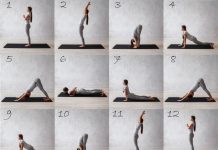Every one of us believe we are experts on ourselves. That we are the best authorities on the mystery we are. How surprised would we be then, if we were to take a peek into the Yogic texts of yore, and find an explanation of our bodies and structures, the likes of which we have never come across before.
Yogic anatomical explanations bring to mind a sci-fi movie of the 21st Century, complete with 3D holograms and close-up views of medical marvels that live within us that we have not fathomed up until now. A cursory acquaintance with Yogic anatomy and we will be familiar with the 5 bodies, planes of existence, or sheaths that comprise the human body – the food body (annamayakosha) or the outermost physical sheath, and the underlying the subtle body with three deeper levels – the energy body (pranamayakosha), the mental body (manomayakosha), and the wisdom body (vijnanamayakosha). At the heart of all of these lies the most sacred part us – the anandamayakosha – the ultimate bliss body, the indestructible self that keeps us filled with optimism, love for living, and simply, Ananda – pure bliss.
This yogic perspective of bodily structure aside, the way this ancient discipline views anatomy is a rich learning in its own right. It enhances our understanding of how our bodies are oriented to receive energy in the form of food and rest, interpret and absorb it internally, and channelize the resulting internally generated force towards productive purposes. Even to a lay yoga practitioner, it has uses; by providing a structural understanding of our bodies, it helps us use our innate strengths and capabilities efficiently to achieve different asanas. It helps us strengthen our weak areas so we can achieve those seemingly simple asanas that we somehow just never manage to quite crack, and it helps us to sustain those of our favorite and most adept asanas to continue to derive the maximum benefit out of them.
All this does sound rewarding doesn’t it? A bird’s eye view of the basics of anatomy a la Yoga sure would help wouldn’t it? Without further ado, here’s Yoga Anatomy 101:
Nadis: We all have learnt that the body is built on a framework of bones, muscles, veins, arteries and nerves: Yoga adds another component to our substructure of bones – the nadi. For a detailed explanation, read this. Literally meaning “tube” or “pipe”, these are invisible channels that are believed to carry Prana throughout our body. Much like blood vessels carry oxygen to different parts, so also nadis, of which there are 72,000, carry the quintessential Prana. Three nadis perform the most important roles here:
- Sushumna: Running just below the spine, this is the home of the Kundalini, the sacred serpent of energy that remains coiled within us, until it is awakened through Yoga, to snake up towards the top of the head, and unleash its energies within us.
- Ida and Pingala: The second and third nadis bracket the Sushumna, the Ida to the left, relating to the cooling feminine energies, symbolized by the moon; and the Pingala to the right, relating to warm masculine energy, symbolized by the sun.
Chakras: These are crucial nodes at which the nadis converge, so-called wheels along which the Kundalini flows. They are 7 in all, and their fame is perhaps the best known and most documented aspect of yogic anatomy.
Prana: Loosely translated as ‘life-force’ or ‘life-energy’, this elusive concept has been translated as breath by Western science, and although that is misleading, the best way to experience, harness and productively channelize the Prana is through the breath. Learn more about this here.
Vayus: literally meaning ‘winds’, 49 Vayus run through our system, of which 5 major Vayus regulate and give pathways to channelize our pranas. They each govern specific parts of our bodies, and help manage various aspects of our well-being.
- Prana Vayu: This rules our chest and head and works in inhalation, intake, and moving forward
- Apana Vayu: This governs the pelvic area, helping with elimination, downward and outward movement
- Samana Vayu: Ruling the navel, this serves to regulate assimilation, absorption and consolidation
- Udana Vayu: In charge of our throat, this vayu regulates speech, growth and moving upwards
- Vyana Vayu: This Vayu works on the whole body, helping with overall circulation, expansiveness and pervasiveness
Modern day science is beginning to recognize that at the quantum level, our bodies function in ways that conventional biology is unable to explain. Their research and findings are slowly repeating and reiterating the core beliefs of yogic anatomical explanations. Till the day the two fields connect, every yoga practitioner will be living proof that our bodies can be pushed to their fullest potential by understanding, and implementing in our daily lives, the above fundamental concepts.
Links in this article:
Chakras: https://celebrateyoga.org/what-are-chakras-in-yoga/
Nadi: https://celebrateyoga.org/what-are-nadis-in-yoga/
Prana: https://celebrateyoga.org/prana-mean-yoga/
47 Most Famous Motivational Quotes of All-Time
49 Greatest Love Quotes
37 Inspirational Quotes that Will Change Your Life






























